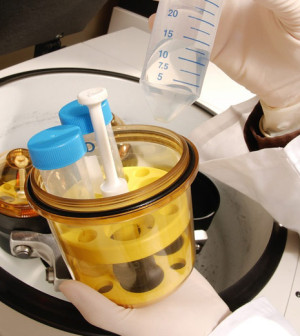- Navigating Your Midlife Crisis: Embracing New Possibilities
- City Raccoons Showing Signs of Domestication
- Mapping the Exposome: Science Broadens Focus to Environmental Disease Triggers
- One Week Less on Social Media Linked to Better Mental Health
- Your Brain Changes in Stages as You Age, Study Finds
- Some Suicide Victims Show No Typical Warning Signs, Study Finds
- ByHeart Formula Faces Lawsuits After Babies Sickened With Botulism
- Switch to Vegan Diet Could Cut Your Greenhouse Gas Emissions in Half
- Regular Bedtime Does Wonders for Blood Pressure
- Dining Alone Could Mean Worse Nutrition for Seniors
Device May Restore Speech to People on Breathing Tubes


Doctors in the Netherlands say they’ve found a potentially important new use for a simple old device — the “electronic voice box.” It may help hospitalized patients who’ve lost the ability to speak because they need tubes down their throat to help them breathe.
The electronic voice box, or “electrolarynx,” was first developed in the 1920s. It’s a cylinder, about the size of an electric shaver that vibrates at one end. It’s been used almost exclusively to help people who’ve lost their ability to speak because their vocal cords have been surgically removed, often after cancer.
“It’s mostly been used in the past. It’s something I saw when I was a student. I saw a patient who was able to talk with the device and it made a huge impression on me,” said Dr. Armand Girbes, an intensive care physician at VU University Medical Center, in Amsterdam.
The device came to mind again when a patient’s wife recently came to Girbes to say that her husband, who was on a mechanical ventilator after lung surgery, was frustrated because he couldn’t speak. Girbes searched the hospital to dig up the only electrolarynx they still had.
“I tried it myself. I put it on my neck,” he said.
After a few minutes of practice, which Girbes said felt a little bit like lip-synching, he used his mouth and tongue to form words without actually trying to make the sounds himself — and he was able to produce intelligible words.
His 59-year-old patient got the hang of it just as quickly.
“I still remember the first thing he said to his wife: He said ‘Hello, my dear.’ That was very moving to hear from a patient who was critically ill in intensive care,” Girbes said.
He reported his success in the March 20 issue of the New England Journal of Medicine.
“I think it’s an interesting idea,” said Dr. Lindsay Reder, an assistant professor of otolaryngology at the Keck School of Medicine at the University of Southern California, Los Angeles. She was not involved in the patient’s case.
“A lot of these patients who are intubated are also on sedation medication because it’s not the most comfortable thing,” Reder said.
For his part, Girbes said a side benefit of using the electrolarynx in ventilated patients is that they might need less sedation (because of reduced stress). Delirium and oversedation are major problems for patients in intensive care units.
Reder said that’s an interesting theory, but one that requires more research to prove for certain.
“I think it’s something we’d obviously need to do more of it in a controlled way to know if it’s widely applicable, but I do think it’s an interesting thing from a quality-of-life and quality-of-care standpoint,” she said.
More information
For ways to help a loved one be comfortable during a stay in the intensive care unit, visit the Safe Patient Resource Center.
Source: HealthDay
Copyright © 2025 HealthDay. All rights reserved.










